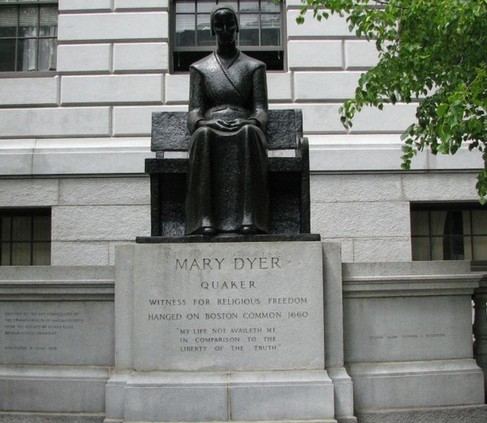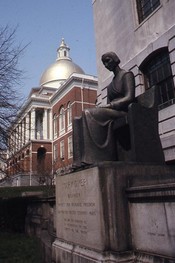Mary Dyer Sculpture
Introduction
Text-to-speech Audio
This stone sculpture depicts the Quaker martyr Mary Dyer who was hung for her religious beliefs in June, 1660. The sculpture was ordered by a bill of the General Court of Massachusetts and was created by the well-known Quaker artist Sylvia Shaw Judson. It was dedicated in 1959 and stands at the corner of Beacon Street and Bowdoin Street in front of the Massachusetts State House.
Images
Mary Dyer Sculpture

Mary Dyer Sculpture

Backstory and Context
Text-to-speech Audio
In 1633 Mary Dyer and her husband William were married in England. In 1635 the couple emigrated to Boston where they joined the Church of Boston. Over the latter half of the 1630’s Boston became increasingly divided over the separation of church and state. Governor John Winthrop restricted the creation of new churches and took it upon himself to make clerical appointments, whilst punishing those who spoke up against these practices.
The prominent Englishman Henry Vane started an opposition party and eventually was elected to governor, but ultimately was defeated by Winthrop and his supporters. One of Vane’s supporters was Anne Hutchinson, an outspoken critic of Winthrop and a close friend of Mary Dyer. As punishment for supporting the opposition, Winthrop ordered the exhumation of Mary Dyer’s stillborn child, which was found to be grotesquely deformed. Winthrop and the other Boston leaders regarded the child’s deformities as the result of Mary’s deformed spiritual beliefs, which allegedly ranged from dissolute living to supernatural communication.
After the exhumation, the Dyers left for Rhode Island with other persecuted individuals including Anne Hutchinson, who had been banished from Massachusetts. In the early 1650’s the Dyers returned to England where Mary joined the Quaker church. Despite the continuing persecution of Quakers in Massachusetts, the Dyers returned in 1657 and Mary began missionary work on behalf of the Quaker church. She was immediately imprisoned and subsequently expelled with the threat of execution if she returned.
Mary risked execution by returning to Massachusetts in order to continue her missionary work on behalf of the Quakers. This time she was sentenced to execution along with two other male Quakers. At the begging of her son William the Governor granted Mary a reprieve, but once again expelled her from the colony. On her third and final return to Boston Mary was arrested and on June 1st, 1660 she was executed on the Boston Common.
The sculpture that stands at the Massachusetts State House was created in 1959 by the Quaker sculptor Sylvia Shaw Judson. Its creation was ordered by a bill of the General Court of Massachusetts that called for the construction of a statue of Mary Dyer to celebrate her commitment to her principles of free speech and conscience. Mary Dyer is the only woman to have been executed in the United States for religious reasons.
Cite This Entry
Schmidt, James, Lucy Meyers, and Clio Admin. "Mary Dyer Sculpture ." Clio: Your Guide to History. May 28, 2024. Accessed April 6, 2025. https://theclio.com/tour/658/11
Sources
"Mary Barrett Dyer." Encyclopedia Britannica. https://www.britannica.com/biography/Mary-Barrett-Dyer.
"Mary Dyer." American National Bibliography. Last modified February 2000.http://www.anb.org.ezproxy.bu.edu/view/10.1093/anb/9780198606697.001.0001/
anb-9780198606697-e-0100247.
"Mary Dyer." Brooklyn Museum. https://www.brooklynmuseum.org/eascfa/dinner_party/heritage_floor/mary_dyer.
"Mary Dyer Statue." Friends Center. http://www.friendscentercorp.org/?page_id=117.
"Notes from the Archives: Mary Dyer Executed #onthisday in 1660." City of Boston. https://www.boston.gov/news/notes-archives-mary-dyer-executed-onthisday-1660.
Setka, Stella. "A Picture of Piety:The Remaking of Mary Dyer as a True Woman in Arthur’s Home Magazine." American Periodicals: A Journal of History & Criticism. http://muse.jhu.edu.ezproxy.bu.edu/article/542234.
"Statue of Mary Dyer." https://www.citywalkingguide.com/boston/statueofarydyer

